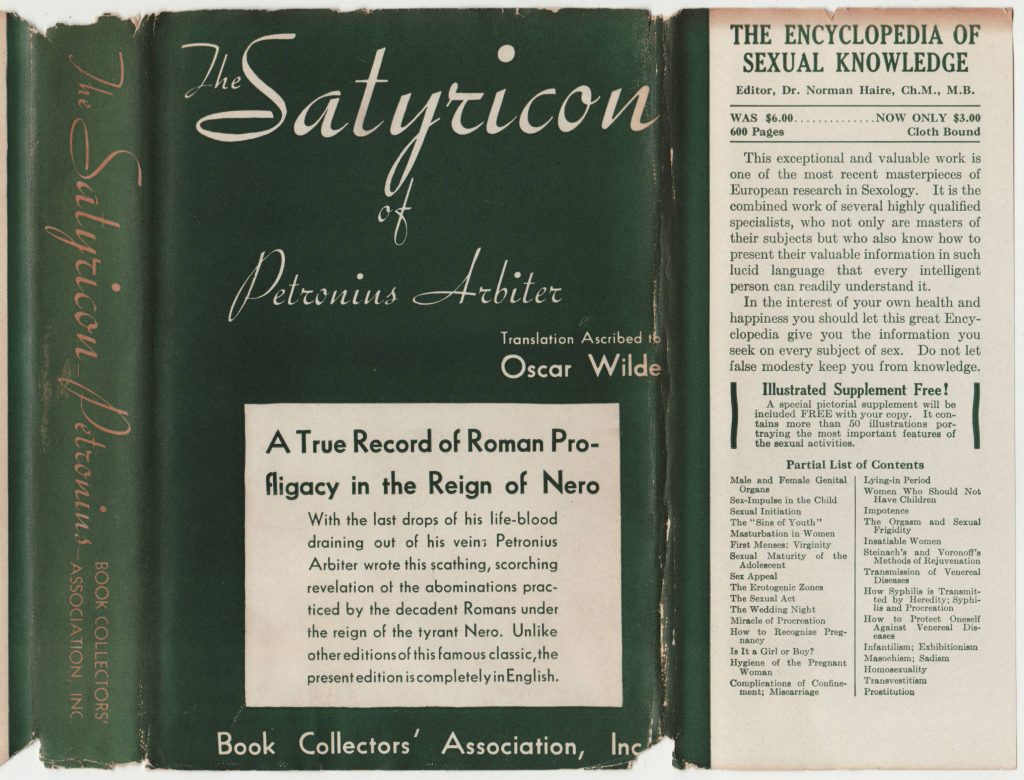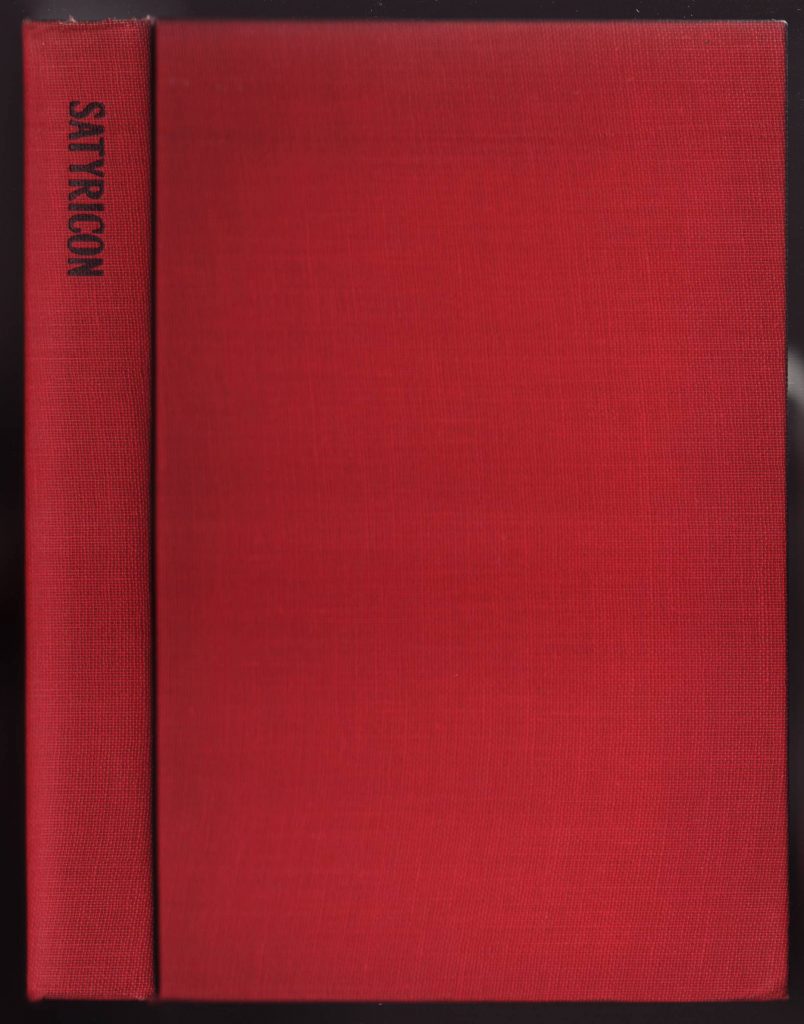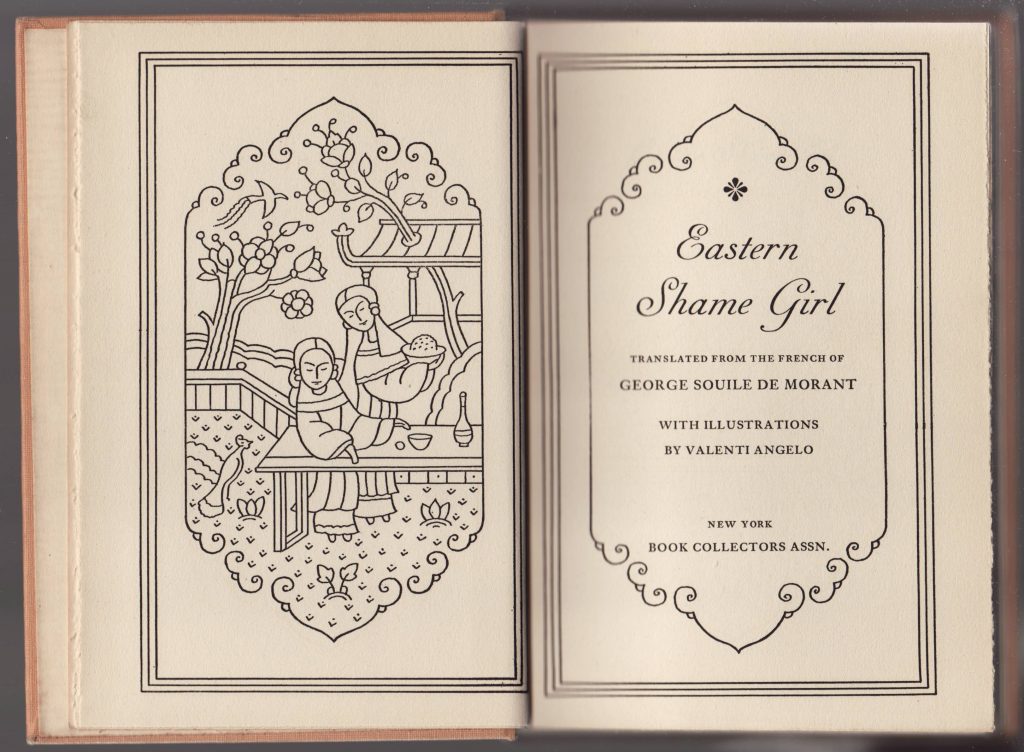Book Collectors’ Association, Inc. (New York, US)
Series dates: 1930-1935
Size: 5″ x 7.5″
Personal Books, Inc. (New York, US)
Series dates: 1935-1955
Size: 5″ x 7.5″
Updated 6/23/2024
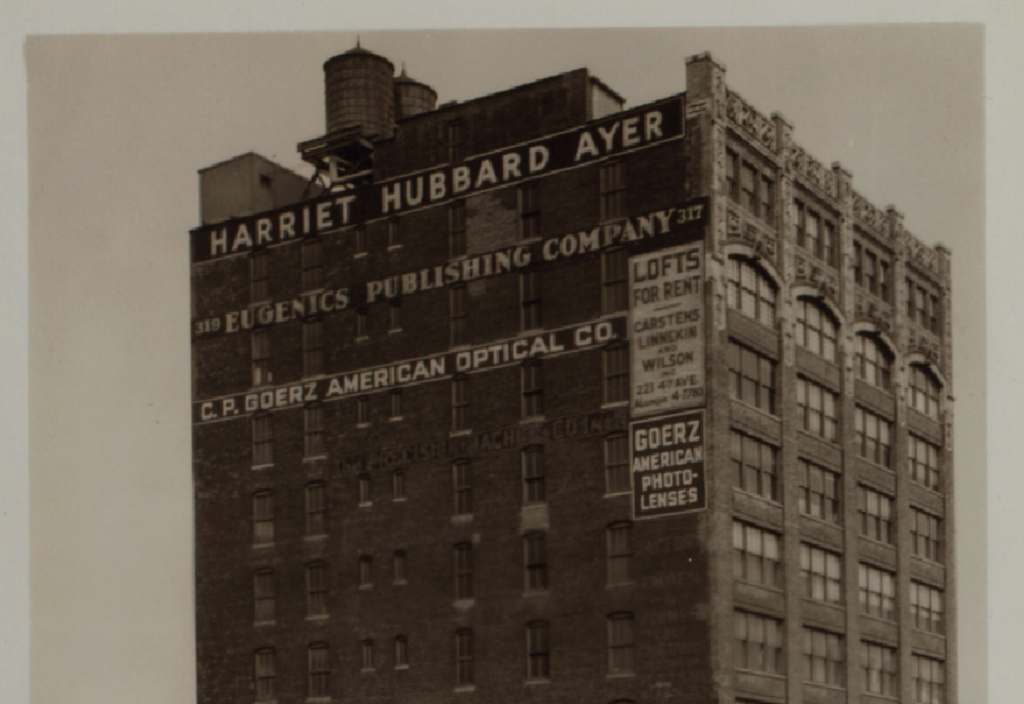
How do you link classic reprint series books to the lurid world of eugenics-fueled erotica?
The Eugenics Publishing Co. was established by atheist activist and author Joseph Lewis around 1927 in New York (it may have existed earlier). The firm published “literature for common people written by medical experts about subjects such as contraception.” Margaret Sanger was among the authors published by the firm. Books published by the Eugenics Publishing Co. walked a fine line between health literature and what would have been considered smut at the time – encyclopedias of sexuality, studies of “sexual savages,” self-help books on sexual troubles, etc., and this led to numerous legal problems for the firm throughout the 1930s.
One could purchase these books in larger cities, but the demand by more circumspect citizens led to a significant number of orders through the mail. Comedian Lenny Bruce, (as related by Jay Gertzman in Bookleggers and Smuthounds, 2001, p. 186) told of a “neighbor lady” to his mother, using “academic medical terminology” and sex stories “from the volumes of books delivered by the postman every month – A Sane Sex Life, Ovid the God of Love, How to Make Your Marriage Partner More Compatible – in plain brown wrappers marked ‘Personal.’” Several of these titles were published by the Eugenics Publishing Co.
The connection between eugenics and erotica in the first half of the 20th century is a curious tale (related in a two-part series on the Textbook History blog). Physician and author William J. Robinson played a significant role, emerging from a traditional medical field with a strong belief in the social force of progressive biology. Birth control was seen as vitally important, as the eugenists’ dream was to restrict the reproduction of undesirable individuals.
A diversity of publicity stunts were used to transform Robinson’s message via seemingly traditional periodical outlets, including a failing journal, Medical Review of Reviews, which he acquired in 1911. Robinson hired an old prep school friend, Edward Bernays, the “father of spin” to help spread the message via these ostensibly legitimate, academic periodicals. An important part of the spin was the idea that erotic tensions and desires could be exploited for the good of the eugenics movement. A book about birth control could, in a manner that was both clinical and erotic, detail the biology of sex and reproduction. Where does one draw the line between biology and pornography? It is that contested space where the Eugenics Publishing Co., which published many of Robinson’s books, was situated.


Sharing an address with the Eugenics Publishing Co. in New York was the American Biological Society. What sounds like a scientific organization was, in fact, an imprint of the Eugenics Publishing Co., issuing many of the same titles with an emphasis on birth control and pseudo-medical sex manuals. Along the same lines (an imprint name that sounded like a legitimate organization), the Book Collectors’ Association, Inc. began publishing titles in 1930. A few titles were along the lines of other Eugenics Publishing Co. books (in particular, a book on the practice of bundling), but the majority were a series of reprinted classics, smaller in size, following the format of many other contemporary reprint series. Published between 1930 and 1935, the unnamed series included the following titles, all with a whiff of the erotic:
Balzac, The Girl with the Golden Eyes (1931)
Pierre Louÿs, Aphrodite (1932)
George Morant, Eastern Shame Girl (And Other Stories) (1935)
Petronius Arbiter, The Satyricon (1934)
Voltaire, Candide (1930)
Oscar Wilde, Salome (no date)
As I speculate below, it is possible that the primary goal of these slightly erotic but literary titles was to lure book buyers into exposure to more erotic materials, such as medical erotica and more straightforward pornography (which, of course, was a dangerous but profitable enterprise). Given the PR skills behind the Eugenics Publishing Co. and their tendency to hijack or create legitimate-sounding organizations as a means of promoting their erotica-themed medical eugenics, it is likely that this was the case. Thus a rather innocent series of classic reprints is a shill in an erotica and pornography marketing scheme.
Legal issues, as could be expected, arose, and by the mid-1930s the Eugenics Publishing Co. and its subsidiaries seemed to be in decline, with reprints of many of the Robinson (and related) erotic medical texts dropping off precipitously. The legal battle was fought by the U.S. government primarily through laws regulating the use of the postal service as a means of transporting pornographic materials. As many of the Eugenics Publishing Co. and subsidiary books were sold and shipped through the mail (those plain brown packages) this was a particularly vulnerable part of their business plan.
In 1935 the president of both the American Biological Society and Book Collectors’ Association, Mark Jacobs, was indicted for circulating obscene literature. Jacobs’ name does not appear in tandem with either Lewis or Robinson, but he was head of several Eugenics Publishing Co. subsidiaries all listed at the same address in New York.

“In Nov. 1935, one of seven booksellers indicted for mailing circulars for obscene literature was Mark Jacobs, then identified as president of the Book Collectors Association. In 1938, Jacobs was associated with the American Biological Society, from whom an FBI investigator purchased a pamphlet of nude photographs. With the order came circulars from Eugenics. The two firms shared a common address, and the agent assumed they were the same business.” (Jay Gertzman, Bookleggers and Smuthounds: The Trade in Erotica, 1920-1940).
Soon after Lewis’ indictment, the jackets on Book Collectors’ Association titles start using the name Personal Books, Inc., possibly an attempt to distance themselves from Lewis’ legal troubles. Titles under that imprint ceased around the mid-1950s.
A Personal Books envelope and advertising flyer are shown below, likely from the later 1930s. The double-sided flyer includes a “special offer” of four sexy titles for an impossibly low cost of 98 cents plus postage. This kind of advertisement was likely not welcome in published materials and may have been stuck in copies of the more mundane Personal Books titles.
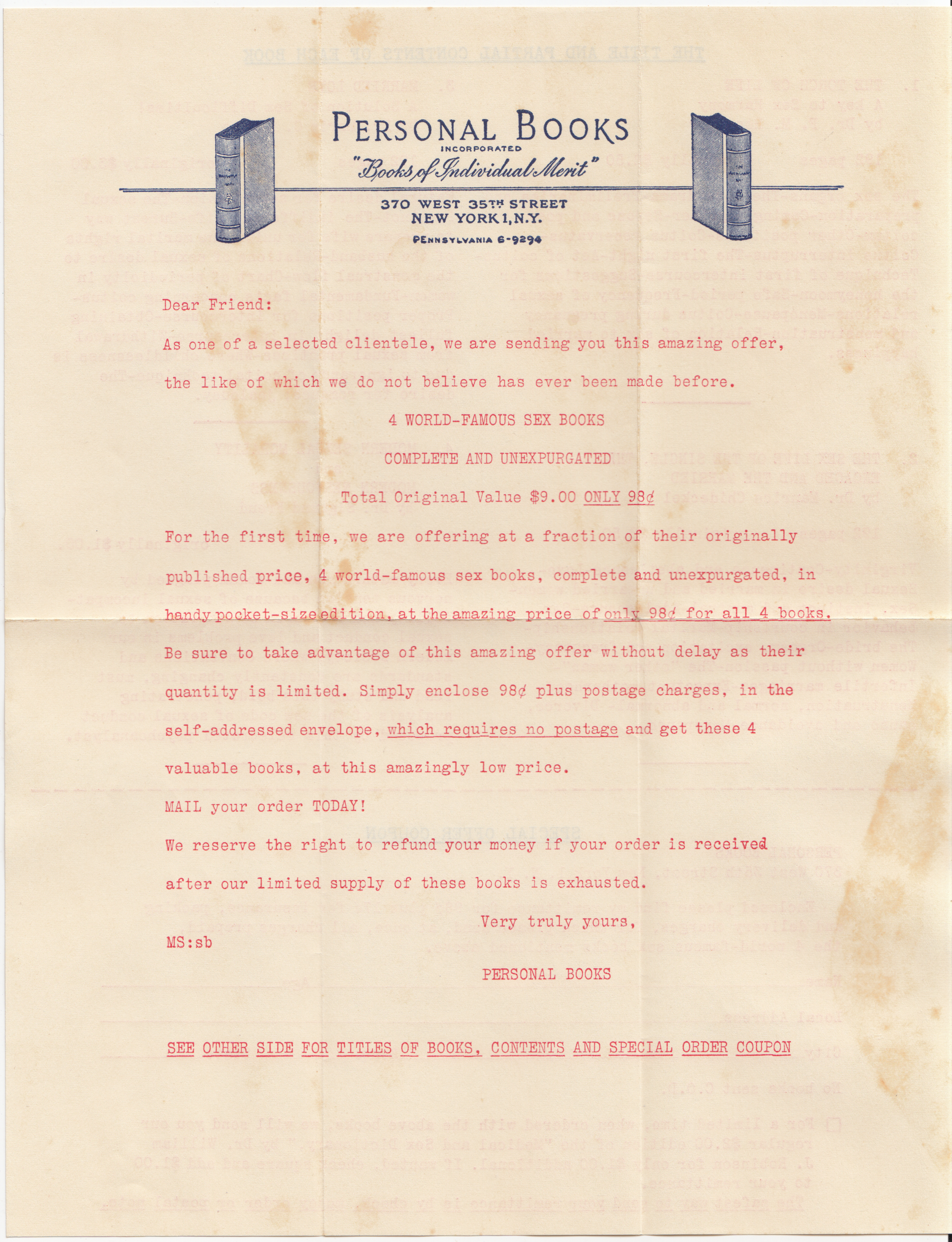 |
 |
Joseph Lewis made a significant amount of money from his Eugenics Publishing Co. imprint and seems to have avoided obscenity charges (although he was certainly involved in many legal battles, many self-initiated, throughout the 1930s). It is not clear how Mark Jacobs, president of two Eugenics Publishing Co. imprints could be indicted on charges related to the imprints without Lewis similarly being charged.
Book Collectors’ Association jackets follow a style reminiscent of other reprint series (and are eerily reminiscent of 1940s-era Modern Library jacket designs) and are unique to each title. In this case, The Satyricon of Petronius Arbiter is a translation ascribed to Oscar Wilde. The copyright date is 1934 but given Eugenics Publishing Co. titles advertised on the jacket were printed around 1936. The Encyclopedia of Sexual Knowledge (first published in 1934) and authored by Dr. Norman Haire, Ch.M., M.B., is advertised on the front jacket flap. The title was advertised elsewhere as “Approved By The American Medical Association.”
The jacket advert for the Encyclopedia includes an offer for an “Illustrated Supplement Free!: A special pictorial supplement will be included FREE with your copy. It contains more than 50 illustrations portraying the most important features of the sexual activities.” One might speculate that the series of classic titles was intended as an advertising vehicle for the much more saucy publications of the Eugenics Publishing Co (such as the Encyclopedia). Further, even more salacious materials were added as a bonus and, it seems, in some cases (once the firm had your address) you may receive offers for even more enticing publications or collections of photographs. In this way, a seemingly mundane classic series book was the first step on a path to the purchase of pornographic material through the mail.
More Eugenics Publishing Co. titles are advertised on the rear of the jacket and rear flap. These books were probably mailed to the purchaser with a brochure offering additional titles.
The binding of this book is strictly utilitarian red cloth with an almost industrial-looking title stamped on the spine. No publisher name is included on the bookbinding – an unusual absence.
The books are well-bound with decent paper but do lack a traditional half-title page. The title page includes the Book Collectors Association imprint.
The copyright is 1934, probably the initial printing of the book. The jacket, at least, was printed in or around 1936 when one of the titles advertised was published. No printer is noted, but the book was printed in the U.S.
Jackets for the Personal Books were the same as the earlier Book Collectors’ Association titles, only replacing the name at the bottom of the jacket front. This copy of Eastern Shame Girl, translated by George Morant, was likely published in 1935. It was the last of the short series of six titles (listed above) and it is not clear if it was ever issued with a Book Collectors’ Association jacket. The front flap advertises the same book (Encyclopedia of Sexual Knowledge) as the copy of the Satyricon, above. The overall jacket design is similar to that earlier title, undoubtedly designed by the same person.
The rear jacket flap advertises, again, the same book as the earlier Satyricon. The rear of the jacket advertises the Satyricon and includes a price of $1.50.
Bindings are sturdy but plain with the title and author. The material is a peculiar flesh-orange-tan color.
The half-title page:
One of the book’s numerous illustrations faces the title page. The illustrator (Valenti Angelo) is noted. The imprint is the Book Collectors Association. This book may have been printed before the name change to Personal Books, as that name only appears on the jackets.
The copyright (1935) is to the Illustrated Editions Co., another somewhat sketchy publisher of titillating illustrated classics. The printer is noted on this book: Little and Ives of New York. This is the same printer used by the Illustrated Editions Co. The book’s title faces the copyright page.
A copy of the jacket from Wilde’s Salome, undated, with Personal Books on the jacket and Book Collector’s Association as the imprint.

